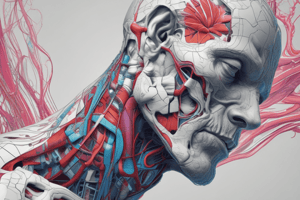Podcast
Questions and Answers
Which of the following levels of organization is the most complex?
Which of the following levels of organization is the most complex?
- Tissues
- Organ systems
- Organs
- Organism (correct)
Which region of the body includes the chest?
Which region of the body includes the chest?
- Thoracic region (correct)
- Abdominal region
- Pelvic region
- Cervical region
Which cavity contains the brain?
Which cavity contains the brain?
- Cranial cavity (correct)
- Abdominal cavity
- Pelvic cavity
- Thoracic cavity
Which directional term refers to the direction toward the midline of the body?
Which directional term refers to the direction toward the midline of the body?
Which system is responsible for controlling and coordinating body functions?
Which system is responsible for controlling and coordinating body functions?
In the anatomical position, what is the direction of the palms?
In the anatomical position, what is the direction of the palms?
Which of the following body systems is responsible for removing waste?
Which of the following body systems is responsible for removing waste?
Which level of organization is composed of epithelial, connective, muscle, and nervous tissues?
Which level of organization is composed of epithelial, connective, muscle, and nervous tissues?
Study Notes
Organization of the Body
- The human body is composed of several levels of organization, from simplest to most complex:
- Chemicals (atoms, molecules)
- Cells
- Tissues (epithelial, connective, muscle, nervous)
- Organs
- Organ systems
- Organism
Body Regions
- The human body can be divided into several regions:
- Cranial region (head)
- Cervical region (neck)
- Thoracic region (chest)
- Abdominal region (belly)
- Pelvic region (hip area)
- Upper limb (arm)
- Lower limb (leg)
Body Cavities
- The human body has several cavities that contain and protect internal organs:
- Cranial cavity (brain)
- Thoracic cavity (heart, lungs)
- Abdominal cavity (digestive organs)
- Pelvic cavity (reproductive organs)
Directional Terms
- Directional terms are used to describe the location of body structures:
- Anterior (front)
- Posterior (back)
- Superior (above)
- Inferior (below)
- Medial (toward the midline)
- Lateral (away from the midline)
- Proximal (near the trunk)
- Distal (far from the trunk)
Body Systems
- The human body has several systems that work together to maintain homeostasis:
- Nervous system (control and coordination)
- Circulatory system (blood circulation)
- Respiratory system (breathing)
- Digestive system (nutrition)
- Endocrine system (hormone regulation)
- Immune system (disease protection)
- Integumentary system (skin and body coverings)
- Muscular system (movement)
- Skeletal system (support and protection)
- Urinary system (waste removal)
Anatomical Position
- The anatomical position is a standard reference point for describing the body:
- Standing upright
- Feet shoulder-width apart
- Arms at the sides
- Palms facing forward
- Toes pointing forward
Organization of the Body
- The human body is organized into six levels: chemicals, cells, tissues, organs, organ systems, and organism.
- Chemicals include atoms and molecules.
- Tissues include epithelial, connective, muscle, and nervous tissues.
Body Regions
- The human body can be divided into eight regions: cranial, cervical, thoracic, abdominal, pelvic, upper limb, lower limb, and vertebral column.
- The cranial region includes the head.
- The cervical region includes the neck.
- The thoracic region includes the chest.
- The abdominal region includes the belly.
- The pelvic region includes the hip area.
- The upper limb region includes the arm.
- The lower limb region includes the leg.
Body Cavities
- The human body has four cavities: cranial, thoracic, abdominal, and pelvic cavities.
- The cranial cavity contains the brain.
- The thoracic cavity contains the heart and lungs.
- The abdominal cavity contains the digestive organs.
- The pelvic cavity contains the reproductive organs.
Directional Terms
- Directional terms are used to describe the location of body structures relative to each other.
- Anterior refers to the front of the body.
- Posterior refers to the back of the body.
- Superior refers to a location above another structure.
- Inferior refers to a location below another structure.
- Medial refers to a location toward the midline of the body.
- Lateral refers to a location away from the midline of the body.
- Proximal refers to a location near the trunk of the body.
- Distal refers to a location far from the trunk of the body.
Body Systems
- The human body has 11 systems that work together to maintain homeostasis.
- The nervous system is responsible for control and coordination.
- The circulatory system is responsible for blood circulation.
- The respiratory system is responsible for breathing.
- The digestive system is responsible for nutrition.
- The endocrine system is responsible for hormone regulation.
- The immune system is responsible for disease protection.
- The integumentary system is responsible for skin and body coverings.
- The muscular system is responsible for movement.
- The skeletal system is responsible for support and protection.
- The urinary system is responsible for waste removal.
Anatomical Position
- The anatomical position is a standard reference point for describing the body.
- It is characterized by standing upright with feet shoulder-width apart.
- The arms are at the sides, and the palms are facing forward.
- The toes are pointing forward.
Studying That Suits You
Use AI to generate personalized quizzes and flashcards to suit your learning preferences.
Description
This quiz covers the different levels of organization in the human body, from chemicals to organism, and the various regions of the body, including cranial, cervical, and more.



